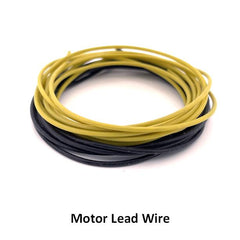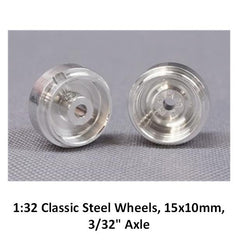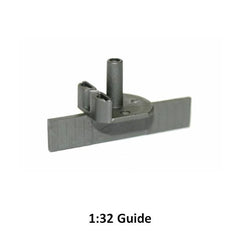Showdown Rolling Chassis Parts (1:32 Builds)
The Home Racing World Showdown Chassis has become increasingly popular with 1:25 and 1:32 scratchbuilders. One of the great things about the Showdown Series is the chassis features a straightforward design that is relatively easy to build. This page describes parts commonly used for a 1:32 Showdown Chassis build. Note our goal is to provide first-time participants with a shopping list. The shopping list is fairly complete; however, there still may be some odds and ends not on the list. As we receive feedback, we are continually updating this section to make it as complete as possible. Click on any of the product pictures for more information or to add the part to your shopping cart.
Before proceeding, if this is your first 1:32 Showdown Chassis build, we STRONGLY recommend spending some time watching the excellent how-to videos put together by Harry Wise and George Pineda. These videos provide detailed step-by-step instructions and show each of the various parts and components that make up a Showdown Chassis. For convenience, we have provided a link to the videos below.
*** NEW *** Complete HRW 1:32 Showdown Chassis Kit!!!
We now offer a complete chassis kit with everything need to build a "roller" chassis for HRW 1:32 Showdown Chassis builds. Click on the thumbnail below for more information.
NOTE: The 1:32 Showdown Chassis Kit includes a 1:25 guide - this is intentional. The wood tracks where the Showdown events are run have deep slots so a 1:25 guide works very well. The 1:25 guide setup is also more straightforward as no guide tube is required. If you plan to run your car on tracks with shallow slots (e.g. most plastic tracks), you can purchase the 1:32 guide, guide tube and braid separately.
Motor Bracket
At the heart of the 1:32 Showdown Chassis is the motor bracket. The bracket not only secures the motor but provides an easy way to secure the rear drivetrain components and chassis rails. The motor bracket shown below was specifically designed for 1:32 Showdown Chassis builds (it can be used for 1:25 and 1:24 builds too). It requires no cutting and works with both short-can (FC-130) motors and long-can (FK-180) motors frequently used for these builds.
Motors
If you're building a 1:32 Showdown Chassis for a proxy or formal 1:32 Showdown event, only the Predator motor shown below is allowed.
Motors are secured to the motor bracket using motor retaining screws like those shown below
Motor Lead Wire
High strand motor lead wire is very flexible making it easy to route between the motor and guide. Silicone insulation won't melt when soldering.
Rear Axle Assembly (3/32" Axle)
For the purpose of this discussion, the rear axle assembly will consist of bushings, axle, crown gear, pinion gear, and wheels. The parts listed in this section are designed for use with a 3/32" diameter rear axle.
Axles (3/32" Diameter)
Axle length will vary depending on the scale of your build, the body you plan to use and how wide you plan to set the rear track width. In general, it is better to use an axle that is a little longer than you may actually need since you can always trim it to the precise length. If you use an axle that is too short, you can't extend its length. Here are some popular axle lengths for HRW Showdown builds.
Bushings (3/32" Axle)
The HW 1" Motor Bracket recommended earlier is designed for use with 3/16" OD bushings mounted inside a 7/32" brass sleeve (made from tubing)
Crown Gears (3/32" Axle)
Since the 1:32 Showdown Chassis uses an inline motor configuration, you'll need a crown gear for a 3/32" axle. Slot.It makes a variety of crown gears ranging from 23 teeth to 30 teeth. The most common crown gear size used for the Showdown Chassis is 27 teeth which is listed below along with slightly smaller (26 tooth) and slightly larger (28 tooth) gears.
Pinion Gears
The pinion gear must match the motor shaft size (diameter) and have the same pitch as the crown gear to ensure proper gear mesh. Slot.It makes several pinion gears designed for inline applications that are designed to work with the Slot.It Crown Gears listed above. The 9-tooth pinion is most commonly used; however, we have also listed slightly smaller (8-tooth) and slightly larger (10-tooth) pinions. Be sure to use a pinion tool when installing or removing a pinion to prevent damage to the motor and/or pinion (refer to the "Tools" section at the end of this page for more information).
Wheels - 1:32 (3/32" Axle)
CB Design Wheels are a popular choice for the 1:32 Showdown Chassis. We recommend a wheel with a center rib. The CB Design Classis Steel 15 x 10mm and 15 x 11mm wheels shown below are two popular choices. Both of these wheels are designed for use with 3/32" axles. Note that most Showdown cars will use the same wheels (and tires) front and back.
If you prefer, you can also use CB Design Insert Wheels in the same sizes shown above; however, HRW Showdown rules require an insert.
Front Axle Assembly
The 1:32 Showdown Chassis uses a no-frills front axle setup. The front axle rides inside a brass sleeve that is used to set the desired wheelbase and front axle ride height. The brass sleeve is then soldered to the two side frame rails. Some builders prefer a square axle sleeve while others use a round sleeve. We prefer the square tubing since the axle will only be contacting four (4) points inside the tubing and the flat surfaces may be easier to position and solder. We've provided links for both sizes of front axle sleeves below.
Sleeves for 3/32" Axle
Front Axles & Wheels
In general, the front axle will be the same diameter and length as the rear axle (see earlier discussion). Again, it is better to error on purchasing an axle that is too long since it can easily be cut to the required length.
Front wheels will usually be the same style as the rear wheels (see earlier discussion).
Guide Assembly
For the Showdown Chassis, the guide assembly consists of a guide tongue, guide and braid. Motor lead wire was covered earlier (see above).
Guide Tongue
A guide tongue provides a sturdy mounting point for the guide. We offer several guide tongues; however, if you are planning to use the 0.82" wide motor bracket recommended earlier, the 0.82" wide guide tongue shown below is the same width. This simplifies laying out and soldering a square HRW Showdown style chassis. If you plan to bend the guide tongue, the narrower guide tongue will be easier to work with.
Guides & Braid
For 1:32 Showdown cars that will be participating in a Showdown event, we recommend a 1:24 guide setup using the parts shown below. Note this is the same guide setup included with the 1:32 Showdown Chassis Kit (see description near the top of this page). This guide setup attaches directly to the guide tongue and is secured with the included nut.
If you are not planning to ship your car to a Showdown event and your track has a shallow slot (e.g. most plastic tracks), we recommend a 1:32 guide. This setup will require a guide tube to hold the guide post. While these can be fashioned from brass tubing, pre-made tubes are readily available.
Chassis Rails & Body Mounting
The front and rear axle assemblies are connected using chassis rails. The Showdown how-to videos show examples. Chassis rails are generally made from square brass tubing, piano wire, or a combination of both. Body mounts can be fashioned using flat brass strip.
Tires (1:32)
1:32 Showdown cars (both classes) require Paul Gage Urethane tires (PGT compound). Sanding can be useful when reducing the tire diameter and/or sanding the contact patch to ensure it is as straight/flat as possible. If you plan to use the CB Design 15x10mm wheels we recommended earlier, use the PGT-22166FF tires shown below. If you plan to the use CB Design 15x11mm wheels instead, use the PGT-22168FF tires shown below.
Resin Bodies (1:32)
1:32 model kits are generally harder to source than there 1:25 counterparts. As such, there is also a more limited selection. We offer 3DP (3D Printed) 1:32 resin bodies that are available for 1:32 Showdown Builds (check the rules for the Showdown event you plan to enter what types of cars/bodies are eligible).
Tools
For best results, you'll need a few tools when building your Showdown Chassis. Slot Car Corner carries some of these tools; however, some items like digital calipers and a soldering iron will need to be sourced elsewhere.
Chassis Jig
A basic chassis jig, like the one shown in the Showdown Chassis how-to videos, will help you layout and assemble the various chassis components. The chassis jig has a honeycomb texture with hundreds of small holes. Small metal pins are inserted into the holes to accurately position chassis components in preparation for soldering.
Soldering Flux
Acid core soldering flux will aid in soldering brass and other metals by removing oxide films which form on the surface of metals. Flux increases the "wetting" ability of solder, causing it to flow more evenly into joints. The acid core flux we offer includes a brush to make it easier to apply where it is needed. Acid core flux should NOT be used on motor lead wires.
Setup Wheels
Setup Wheels make it easier to precisely align the motor bracket, bushings, sleeve tubing and axle. There are two (2) sizes available - 12mm and 15mm. For the SCC Standard and Narrow Motor Brackets, use the 15mm Setup Wheels. If you plan to use the SCC Slim Motor Bracket, use the 12mm Setup Wheels.
Pinion Puller / Press
A pinion puller / press tool is essential to install and remove pinions without damaging the motor and/or pinion. We offer a couple of very high quality pinion puller / press tools.
Wire Bending Machine
If you are planning to use piano wire (sometime called "music wire") in your build, a wire bending machine can be very useful. The wire bending machine makes it much easier to bend the piano wire as required for your chassis build.
Hex Drivers
Wheels and crown gears are secured to the axle using set screws. If you plan to use 3/32" axles, the recommended wheels and gears use M2 set screws. You will need a 0.9mm hex driver to tighten and loosen the M2 set screws. If you plan to use 1/8" axles, the recommended wheels and gears use 4-40 set screws. You will need a 1.3mm hex driver to tighten and loosen the 4-40 set screws.
Digital Calipers
Digital calipers are an essential tool to build the Showdown Chassis. While we don't offer digital calipers for sale, we have included links to examples of digital calipers that are affordable and well-suited for chassis building. We have no affiliation with these suppliers nor do we endorse them.


















































